 Simulated view of Opportunity in "Endurance Crater."
Simulated view of Opportunity in "Endurance Crater." When the robotic rover Opportunity landed on Mars in January, 2004, the engineers who designed it hoped that it would last at least 90 Martian days (sols) and run for up to one kilometer. Six years later, it’s still functioning and has traveled over 20 kilometers. With the new software that was recently uploaded, the rover has become even more useful.
Displaying NASA’s love of acronyms, the new upgrade is called Autonomous Exploration for Gathering Increased Science (AEGIS). It allows the rover to autonomously choose promising rocks or other targets for further study, based on programmable selection criteria, rather than first transmitting images to the rover team on Earth and awaiting instructions. Because it takes about a day to collect data from the rovers and send back new instructions, giving Opportunity the ability to proceed alone is a huge advantage.
The first rover-selected study object was a tan football-sized rock. Opportunity chose this rock out of a field of more than fifty objects visible to its camera. Tara Estlin, a rover driver and senior member of the Jet Propulsion Laboratory’s artificial intelligence group, was pleased with this choice:
It found exactly the target we would want it to find. This checkout went just as we had planned, thanks to many people's work, but it's still amazing to see Opportunity performing a new autonomous activity after more than six years on Mars.
No comments:
Post a Comment